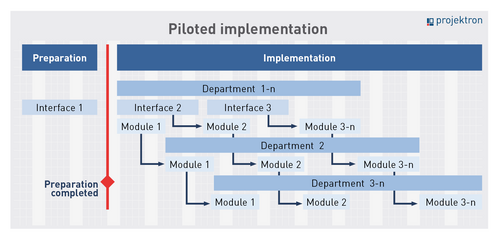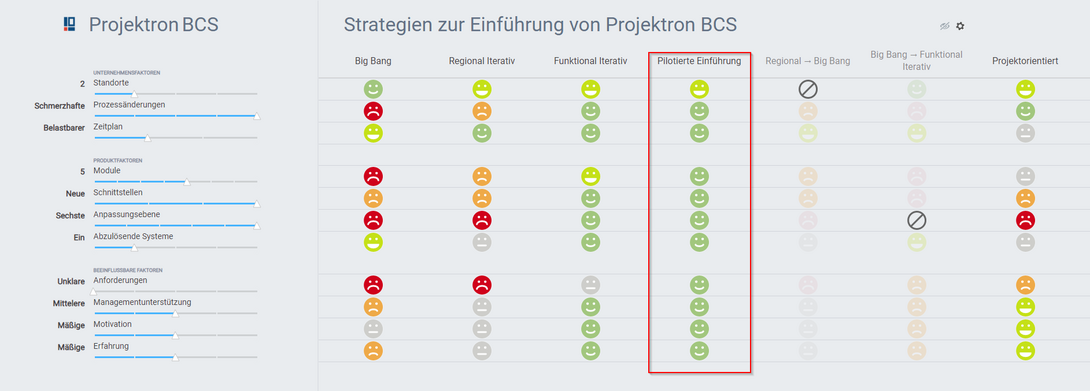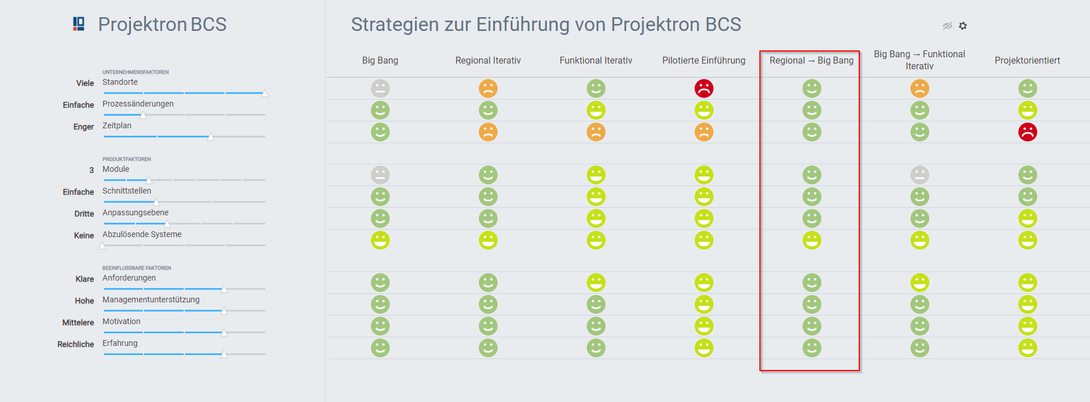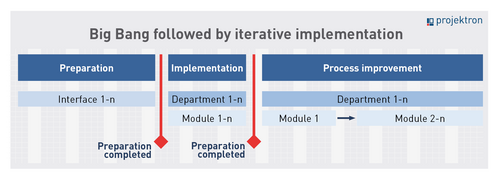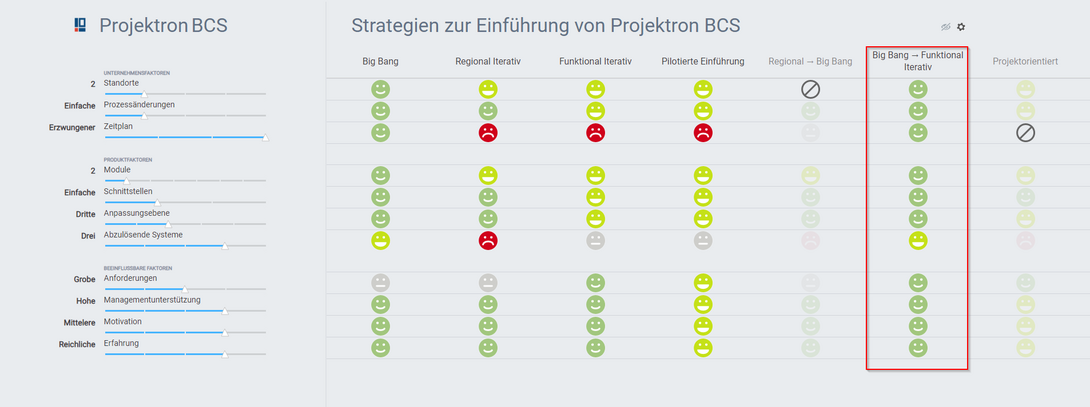02/28/2023 - Articles
Combined implementation strategies: A combo for successful software implementation
Combined strategies for introducing enterprise software integrate the big bang method and iterative process models. This allows them to be adapted more precisely and individually to the needs of the company in large implementation projects. Find out here which combination of introduction strategies is suitable for which companies, what the respective advantages and disadvantages are, and which strategy you should choose for your introduction project of complex enterprise software.
Why are there combined strategies for software deployment?
In addition to software introduction according to the Big Bang method and iterative procedures, other software introduction strategies come into question which may be more suitable for software introduction projects in companies in individual cases. Widely known and clearly outlined are the Big Bang strategy, and three iterative introduction strategies:
Software introduction after Big Bang
In the big bang strategy, all software modules are activated for all users on a specific date. The new software replaces the legacy system holistically, so users do not have to maintain processes in the new and legacy systems in parallel. However, the risk is high.
Project-oriented rollout
The project-oriented software rollout is a variant of the iterative, i.e. step-by-step software rollout. A small project team initially uses the new software as a tiger team in a typical company project. After appropriate adjustments, the rollout takes place company-wide.
Functional iterative implementation strategy
Functional iterative software rollout is a variant of iterative, step-by-step rollout of modular enterprise software. In this approach, the individual functional modules of the new software are introduced into the company one after the other
Departmental or regional iterative rollout
The regional iterative software rollout and the departmental iterative software rollout, which follows the same principle, are variants of the iterative, step-by-step rollout. A company introduces a software completely with all desired function modules successively at different locations or departments.
In large-scale implementation projects of complex enterprise software, however, other strategies are also used in practice, consisting of combinations of these four strategies. Combined strategies offer the advantage that they can be better adapted to the individual needs and requirements of the company and can thus mitigate the risks of software introduction, shorten introduction times or increase acceptance of software introduction. The combination of different strategies can accumulate the specific advantages of the individual variants.
What are the combined deployment strategies?
In der Praxis sind verschiedene Einführungsstrategien beliebig kombinierbar. Drei geläufige Kombinationen sind folgende:
- Pilotierte Einführung: Bei der Kombination der regional und der funktional iterativen Einführung wird jedes Modul zeitlich versetzt regional iterativ im Unternehmen eingeführt.
- Regional iterative Einführung mit anschließendem Big Bang: Zunächst wird schrittweise über die Standorte oder Abteilungen eingeführt. Sobald genug Erfahrungen gesammelt und die angefallenen Probleme gelöst wurden, wird in den restlichen Standorten nach Big Bang eingeführt.
- Big Bang mit anschließender funktional iterativer Einführung: Die Software wird ohne vorbereitende Absprachen zu den sich ändernden Prozessen nach Big Bang eingeführt. Die Anpassungen werden danach vorgenommen.
Theoretisch sind mehr Kombinationen als die hier aufgeführten möglich.
Piloted implementation: gentle procedure for minimal risk
The piloted introduction is a combination of regionally iterative and functionally iterative introduction. Individual software modules or module groups are implemented regionally iteratively in the company with a time lag. This procedure takes a long time until the implementation is completed.
However, the actual rollout can start very quickly because the software provider only has to set up the interfaces of the first module in advance, making the project preparation phase less time-consuming.
If any technical problems occur, there is enough time to fix them before the implementation of the same module at the second site begins. Also, employee issues that arose during the process changeover can be resolved after the initial implementation phase. This significantly reduces the risk per iteration step. Even relatively inexperienced project managers can successfully implement the rollout project.
Piloted software implementation: advantages and disadvantages at a glance
 |  |
|
|
| |
| |
| |
|
When is the piloted software rollout useful?
The piloted implementation is ideal when the requirements and the desired scope of functions are still unclear. Step by step, a limited number of users specify the requirements as the rollout progresses. The introduction should begin at the location or in the department with the greatest motivation. As the first module, the stakeholders should select the one with the expected greatest benefit for the customer company.
The piloted strategy is particularly suitable when
- at least two, but no more than five functional modules are to be introduced,
- the software is to be introduced at at least two locations or departments,
- new interfaces are to be configured and far-reaching adjustments are to be made
- not many legacy systems need to be replaced,
- the management is not fully behind the project
- the project manager has only moderate experience,
- the requirements are unclear
- the desired scope of functions is still unclear
- the staff is only moderately motivated
When is piloted implementation not useful?
If you have only one or many sites and departments, piloted implementation is not suitable because it is too time-consuming. In this case, you should choose a functionally iterative or project-oriented implementation strategy. If you have a tight schedule or many systems to be replaced, a big bang rollout or combined strategies with big bang are recommended..
Regional iterative software rollout followed by big bang
The software is introduced step by step across the sites or departments. In the process, all those involved in the process gain experience and solve any problems that arise. After this regional test introduction has been completed, the software is introduced at all other sites with all modules in a big-bang process. The more heterogeneous the working methods and requirements of the various departments are, the more departments or sites should initially proceed iteratively.
The strategy is recommended if the new solution is to be introduced in many (at least 4) departments or sites, but there are still uncertainties regarding the new processes. The phased introduction reduces the risks and newly gained experience is incorporated into the procedure for the next phases. In order for controlling to function during the introduction phase, development must prepare temporary interfaces.
Regional iterative rollout followed by big bang: advantages and disadvantages at a glance
 |  |
|
|
|
|
|
|
|
When does a regional iterative rollout followed by a big bang make sense?
Regional iterative implementation followed by a big bang is the best strategy when only a few modules of a modular enterprise software are to be implemented in many locations or departments of a company or group and the design of future departure processes has not yet been finally clarified before implementation begins.
When is a regional iterative rollout followed by a big bang not appropriate?
The more modules are to be implemented and the more legacy systems are to be replaced, the less profitable and riskier the regional iterative implementation with subsequent big bang becomes. If the new software is to be introduced in fewer than four locations or departments, this rollout variant does not make sense.
Big bang with functional iterative implementation: when time is of the essence
When time is of the essence and a rollout must be done on very short notice, this variant of Big Bang, which we also call the "kamikaze method", is sometimes the only remaining option. This is the case, for example, when
- Necessary replacement of the legacy system due to data protection or data security requirements.
- Spin-off or takeover of a company
- Timely expiration of licenses
The implementation follows Big Bang, but the project preparation is kept as short as possible. Necessary process adjustments and employee training only take place gradually after the rollout..
The risk is very high with this variant, since no testing of the new system takes place before the introduction. It may turn out too late that the software does not meet expectations in terms of functionality or usability, and that it meets with resistance from the workforce. This implementation strategy therefore requires an experienced project manager who can explain the strategy to users transparently and competently.
Big bang with functional iterative rollout: overview of advantages and disadvantages
 |  |
|
|
|
|
|
When is big bang with functionally iterative implementation useful?
Big bang rollout followed by functional iterative rollout is the best strategy when all users need to use all modules within a short time. In this way, tough deadlines can be met, for example when the licenses of the software to be replaced expire. If many legacy systems are to be replaced, this variant is the only option besides a pure big bang introduction.
When is Big Bang with functionally iterative rollout not reasonable?
The more employees and the more departments are affected by the software introduction, the more problematic the use of this "kamikaze method" becomes. The abandonment of process discussion would lead to a lot of unrest in the company. If no experienced project manager is available, this approach carries too much risk. Ideally, external expertise should be called in. For more than two functional modules, more time-intensive implementation methods such as functional iterative or project-oriented implementation are recommended.
Which implementation strategy is right for my business?
If you are considering a combined enterprise software rollout, there are many ways to improve your chances of success. It is important to consider the 11 factors that influence the choice of the appropriate strategy and to take appropriate measures to optimize these factors. In this way, you can significantly increase your chances of successful software adoption.
If you are unsure whether a regional or departmental iterative introduction of enterprise software is the appropriate approach for your implementation project, you can count on our expertise. With decades of experience in the introduction of complex software solutions, we can support your project team individually and competently through strategy finding, training, workshops and consulting.

About the author
Francisco Josué Artaza has been working with Projektron GmbH for 15 years, currently as marketing manager and user consultant. He is certified in IPMA, PRINCE2, and as a Scrum Product Owner. He is an expert in software implementation strategies and has developed a tool that facilitates the selection of the appropriate strategy.




